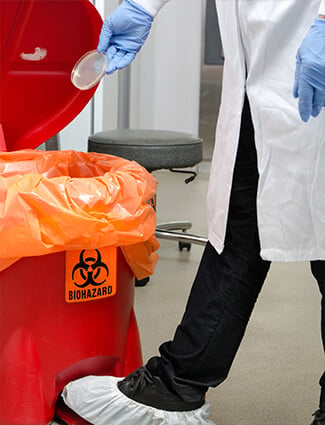Demand Rises in Cleanroom Manufacturing
03
February,
2023
2 MINUTE READ

Quality control and precision data are driving a change in manufacturing giving way to a rise in cleanroom technology, especially during COVID-19 for social distancing and sanitation. Amazing applications and experiments are going on inside these sterile environments, such as growing organic produce, injection molding manufacturing, nanotechnology development, aerospace tool manufacturing, and military applications, just to name a few advancing examples. A variety of industries are embracing the power cleanrooms provide and the need for cleanroom technology is on the rise for efficiency, quality control, and safety.
Cleanroom Growth
Companies are seeing the benefits that come with producing products in a high-quality, technological environment that cleanrooms provide. Cleanroom technology is used for manufacturing aseptic medical goods or for research and development purpose. Those markets are seeing lucrative demand and growth. According to global market data hub Research and Markets, the global cleanroom technology market is about $3.6 billion, with growth expected at 6% each year for the next several years. North America is expected to dominate the market with Asia quickly behind.
Companies that are already ingrained in the cleanroom market are aiming to keep pace. In 2016, the injection molding company Cadence Inc. began enhancing and expanding its cleanroom capabilities for assembly and automation. In 2017, the company doubled its capabilities at its Florida site. Biotechnology company Brammer Bio is another. In 2019, the Massachusetts company says it plans to add a 50,000 square-foot facility that will include commercial ready cleanrooms for vector manufacturing.
"Today, we offer clients access to capacity at a variety of scales, and with a personalized manufacturing approach that is focused on safety, quality, process robustness, and fulfillment of their product goals," said Christopher Murphy, chief manufacturing officer at Brammer.
Safety is Imperative
For cleanrooms to be functional, efficient, and safe, they must not waiver from sustained contamination and control levels. Contamination can easily happen in cleanroom environments with something as simple as using everyday tools and common chemicals. This, in turn, can cause injury to a worker. To maintain a clean and safe environment, establish a cleanroom management program that follows safety best practices as well as OSHA compliance. Incorporate protocol, such as ergonomic, electrical, and chemical safety, using clear organization to help sustain the working environment. Take simple steps to help keep up cleanroom integrity:

- Continually review safety data sheets. Keep a current list of any chemicals have approval for use in the workspace.
- When entering a cleanroom, it is important to ensure the correct use and wear of personal protective equipment. Ensure PPE is organized and clearly marked for use.
- Mark work area boundaries. Include communication of dressing areas, shoe cover/sticky floor surface boundaries, corridors, etc. Clearly define aisles for walking or locations for equipment and materials to prevent slips, trips, and falls.
- Use floor markings such as arrows to mark foot traffic paths and those to signal safety stations, such as an eye wash area and emergency/medical kit stations.
- Label items, such as shoe covers, gowns, glove boxes, chemicals that need glass containers and those that can be in plastic.
- Work with chemicals in their designated areas. Label tanks/baths. Do not leave chemicals unattended without a label. Label all mixtures. Mark hazardous waste bins/areas.
- Provide a quick reference emergency poster that includes fire and Hazmat procedures.
Cleanroom manufacturing helps provide better quality of products and safety of working personnel. Designing cleanrooms takes methodical and proactive customization to meet production goals. Keeping the cleanroom facility neat and organized increases productivity. Start by creating a cleanroom facility management program that includes user information, best practice tips, safety procedure reminders, hazard communication label information, and more. Train cleanroom technicians with up-to-date resources, guides, videos, and more.
RELATED RESOURCES

Workplace Safety During the Coronavirus Pandemic
Workplaces and their employees can stay on top of coronavirus prevention and potential spreading through ...
Read
Tips for Better Chemical Safety Management
Workplace chemical safety is all about understanding the risks and following proper protocol. Train and ...
Read
Simple Tips for Workplace Chemical Safety
New chemicals are created every day for a variety of applications in industry. Working with chemicals and ...
Read.png)


